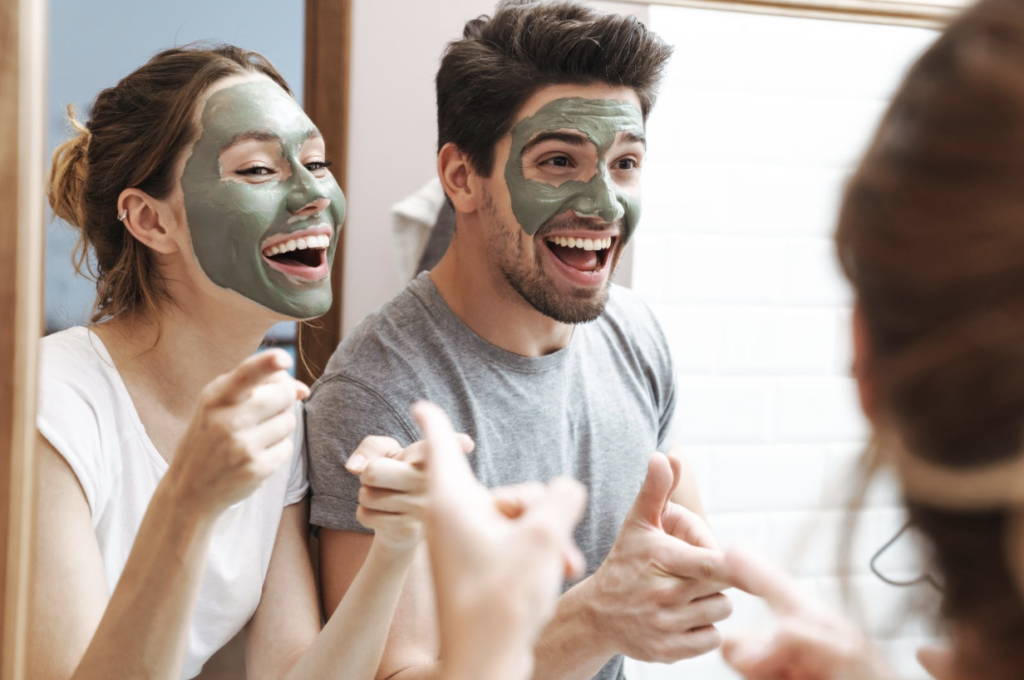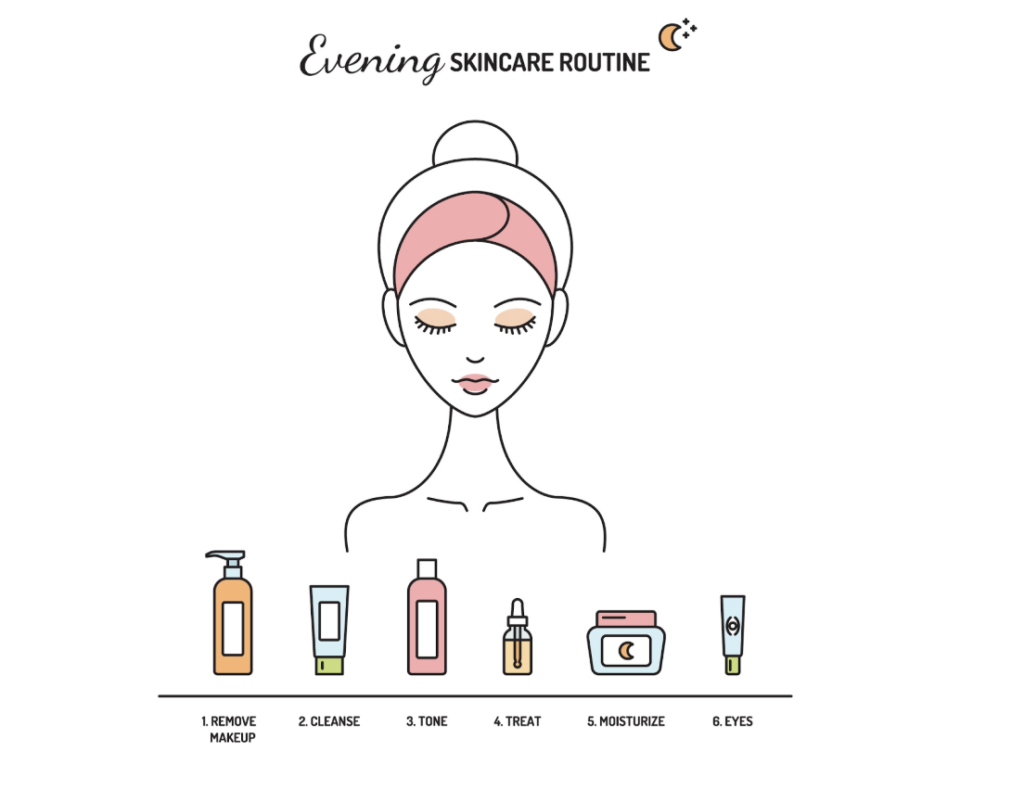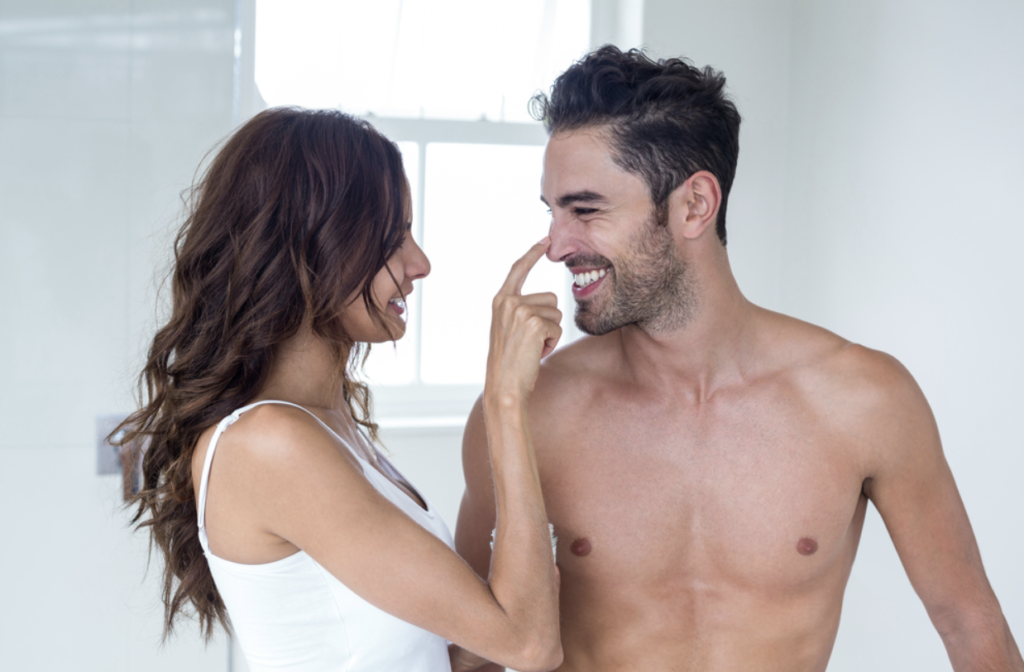A daily skin care routine doesn’t have to be as daunting as it sounds. Whether you’ve got dry, oily, or aging skin, there’s a perfect routine with natural products that will make it look and feel great, both in the morning and the evening.

What is a GOOD skin care routine?
A good, thorough skin care routine consists of 3 basic steps: cleansing, moisturizing, and protecting the skin. Washing your face, hydrating it, and keeping it safe from the sun is key.
The goal of your skin care regimen should be to take good care of your skin, brightening and nourishing your complexion to keep it free from breakouts and maintaining its health.
You must know your skin, especially if you have sensitive skin, to ensure that you use the most beneficial products.
Morning Skin Care Routine
During your morning skin care routine, start with cleansing the face. Applying a gentle cleanser and then patting dry is the way to go, saving the exfoliators for your night time routine.
Be sure to choose the best cleanser for your skin type, avoiding irritating chemicals, and possibly only using micellar water or just plain water.
For the next step, you can move to a hydrosol or toner. Though not necessary, toners like witch hazel can be useful for additional cleansing, removing excess dirt, oil, and makeup. Hydrosols often have essential oils such as lavender or rose that activate and refresh the skin. If you are looking for a simpler morning routine, you can skip this step!
If you typically use a prescription cream or antioxidant serum, it is best to use it after cleansing and before moisturizing. Some natural serums with antioxidants include nourishing vitamin C or CBD.

A pea-sized amount is all you need for the entire face. The serum is applied before moisturizer so that it seeps into the skin. Let it sit for a minute or so before applying a moisturizer.
The next important step in your morning skin care regimen is moisturizing. There are a few types you can use to keep skin soft and refreshed. Many opt for a moisturizing cream or an oil. Natural oils, such as argan or avocado oil, are excellent choices that can regulate sebum and reduce inflammation associated with acne.
When applying a cream or lotion, it is best to apply a small amount to the whole face, approximately the size of a dime. When applying an oil, you can do this by patting it on the face and then massaging it into the skin.
An essential part of a morning skin care is probably the one most people forget to follow: sunscreen.
Protecting the skin against UV rays can not only prevent sunburn, but hyperpigmentation and other sun damage. Some moisturizers have sunscreen in them already, killing two birds with one stone. There are several broad-spectrum, natural sunscreens on the market that are best when looking to avoid harsh chemicals.
Finally, after cleansing and applying all serums, moisturizer, and sunscreen, makeup can be added to enhance your natural features and beauty.
Evening Skin Care Routine
An evening skincare routine will involve makeup removal. If you wear makeup during the day, be sure to remove it before you go to bed. Sleeping in it can cause issues such as acne flare-ups or dry complexion.

First, makeup can be removed with an oil-based cleanser and a cleansing brush or cotton pad to help do the trick. Using these tools helps to remove makeup residue without scrubbing the skin too hard and causing irritation.
An oil cleanser is gentle and can easily slide away any base makeup from the face. Jojoba oil works as an excellent natural makeup remover. You can mix it with aloe or witch hazel or micellar water.
During your evening routine, you can also try double cleansing. This involves ridding the skin of makeup first, and then washing the face again with just a regular cleanser. The second cleansing helps to remove sebum, dirt, and any excess makeup from the face.
As far as skin on the rest of the body, if you washed in the morning, you can skip evening cleanse. Washing too many times may irritate the skin.
For those of you who don’t typically wear makeup, you may try jumping right to a water-based cleanser to wash the face. If you use an exfoliant, it can be used after removal of your makeup and cleansing. Exfoliants include sugar, salt, oats, and coffee for natural exfoliants made at home. If you have blemish prone skin, scrubs and exfoliants are well-known to aggravate acne so avoid them.
Witch hazel or another natural toner can be used next to prepare your skin heightened absorption if you would like. For simpler routine, you may opt to skip this step.
For skin that suffers from acne or any other condition that requires treatment, now is the time to spot treat. Our skin spends the night repairing and restoring, making skin care treatments, such as retinol creams or prescription tretinoin cream and serums, more effective in the evening.
Once the treatment is applied, moisturizer can then be incorporated, sealing any treatments you applied previously.
Night moisturizers and creams are generally thicker and heavier because they can be absorbed over the course of several hours while you sleep. A generous amount of a thicker moisturizing cream can be used before bed.

Tips for Different Skin Types
Dry Skin
- For those with dry skin, it may be helpful to take shorter baths or showers using cooler water instead of hot water. Hot water and exfoliating too much can irritate the skin and strip it of natural oils. Remember to moisturize your skin after bathing.
- Avoid potential skin irritants such as fragrances or dyes. Some natural products with ingredients that may be beneficial for dry skin include rosehip oil, chamomile lotion, and various hydrating face masks.
- Staying hydrated and maintaining an adequate daily water intake can improve skin thickness and density, keeping your skin healthy.
Oily Skin
- Oily, acne-prone skin can be frustrating, but practicing consistent skin care may help to tame breakouts and blackheads. Washing your face twice a day and avoiding unhealthy, processed foods is a good start.
- Some oils like olive oil and coconut oil are good for other skin types, but those with oily skin should stay away to avoid clogging pores.
- Some home remedies for oily skin include aloe vera or green tea face masks.
- When dealing with severe or persistent acne, be sure to make an appointment with your dermatologist for further questions.
Aging Skin
- Signs of premature aging include sun spots, inflammation, hyperpigmentation, fine lines, and wrinkles. Though you can’t stop yourself from aging, you can start to treat your skin kindly.
- As far as anti-aging techniques go, wearing a sunscreen with at least 30 SPF daily protects your skin from hyperpigmentation, UV rays and sagging skin. Aloe vera and vitamin C products may treat sunspots.
- Drinking water and moisturizing skin daily is of course beneficial to all skin types, including aging skin.
In Summary
- Having both a morning and evening skin care routine with natural ingredients is important to maintaining healthy skin and treating any issues you may have, including oily, dry, or aging skin.
- During your morning routine, one typically starts with cleansing, followed by treatments for skin issues, and then moisturizing. Moisturizing with natural oils keeps skin from drying out.
- Applying a sunscreen to protect against UV rays, preventing from sun damage or hyper pigmentation is vital to the morning skin care routine.
- During your evening routine, makeup can be removed with an oil based cleanser. Some follow makeup removal with cleansing once more to remove any excess dirt.
- After optional exfoliation, toning, and applying treatment, is moisturizing. Using a thicker cream is typical for the evening, as the product can be absorbed while you sleep.
Sources
- Ananthapadmanabhan, K. P., Moore, D. J., Subramanyan, K., Misra, M., & Meyer, F. R. A. N. K. (2004). Cleansing without compromise: the impact of cleansers on the skin barrier and the technology of mild cleansing. Dermatologic therapy, 17, 16-25. Abstract: https://onlinelibrary.wiley.com/doi/abs/10.1111/j.1396-0296.2004.04S1002.
- Loden, M., Andersson, A. C., & Lindberg, M. (1999). Improvement in skin barrier function in patients with atopic dermatitis after treatment with a moisturizing cream (Canoderm). The British journal of dermatology, 140(2), 264-267. Abstract: https://europepmc.org/abstract/med/10233220
- Tran, T. N. T., Schulman, J., & Fisher, D. E. (2008). UV and pigmentation: molecular mechanisms and social controversies. Pigment cell & melanoma research, 21(5), 509-516. Full Text: https://www.ncbi.nlm.nih.gov/pmc/articles/PMC2733367/
- Pappas, A., Johnsen, S., Liu, J. C., & Eisinger, M. (2009). Sebum analysis of individuals with and without acne. Dermato-endocrinology, 1(3), 157-161. Full Text: https://www.ncbi.nlm.nih.gov/pmc/articles/PMC2835908/
- Popkin, B. M., D’Anci, K. E., & Rosenberg, I. H. (2010). Water, hydration, and health. Nutrition reviews, 68(8), 439-458. Full Text: https://www.ncbi.nlm.nih.gov/pmc/articles/PMC2908954/
- Bowe, W. P., Joshi, S. S., & Shalita, A. R. (2010). Diet and acne. Journal of the American Academy of Dermatology, 63(1), 124-141. Abstract: https://www.sciencedirect.com/science/article/abs/pii/S0190962209009670
- Ganceviciene, R., Liakou, A. I., Theodoridis, A., Makrantonaki, E., & Zouboulis, C. C. (2012). Skin anti-aging strategies. Dermato-endocrinology, 4(3), 308-319. Full Text: https://www.ncbi.nlm.nih.gov/pmc/articles/PMC3583892/
